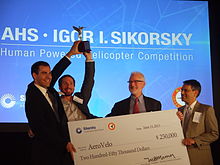| Atlas | |
|---|---|

| |
| Aerial view taken soon after the first flight of AeroVelo's Atlas human-powered helicopter | |
| Role | Human-powered helicopterType of aircraft |
| National origin | Canada |
| Manufacturer | AeroVelo |
| First flight | 28 August 2012 |
| Number built | 1 |

The AeroVelo Atlas is a human-powered helicopter (HPH) that was built for AHS International's Igor I. Sikorsky Human Powered Helicopter Competition. On 13 June 2013, it became the first aircraft to achieve the goals of the competition and thus won the prize.
Design and development

AeroVelo, a team of students and graduates of the University of Toronto, began flight testing its Atlas quad rotor HPH on 28 August 2012. The core team of AeroVelo is the same group that created Snowbird, the first successful human-powered ornithopter. The Atlas is the largest HPH ever flown, and has a tip-to-tip rotor span of 154 ft (47 m), second only to the Russian Mil V-12.
The peak power of 1.1 kW (1.5 hp) was generated only during the first few seconds to climb to the required 3-metre (9.8 ft) altitude. By the end of the flight, power had reduced to 600 W (0.80 hp). Todd Reichert, the pilot and a racing cyclist, had specifically trained for such a power profile. The design specifically took advantage of the ground effect possible by the altitude required to win the prize.
Control was created by leaning the bike, which flexed the entire helicopter frame, tilting the rotor axes.
Operational history
The AeroVelo Atlas HPH made its first flight on 28 August 2012. On 13 June 2013, with a flight commencing at 12:43PM EDT, the team managed to keep Atlas in the air for 64.11 seconds, reach a peak altitude of 3.3 m (11 ft) and drift no more than 9.8 m (32 ft) from the starting point.
Data from that flight was submitted to AHS International. After this was reviewed by its panel of vertical flight technical experts, AHS International announced that the flight had met the requirements of the competition and that AeroVelo had officially won the $250,000 prize on 11 July 2013.
A section was donated to the New England Air Museum in 2017.
Specifications
Data from Aviation Week and Space Technology 15 July 2013
General characteristics
- Crew: 1
- Empty weight: 55 kg (122 lb)
- Gross weight: 128 kg (282 lb)
- Powerplant: 1 × human , 1.1 kW (1.5 hp)
- Main rotor diameter: 4 × 20.2 m (66 ft 2 in)
- Main rotor area: 1,282 m (13,768 sq ft)
Performance
- Service ceiling: 3.3 m (11 ft)
See also
References
- "AHS Congratulates AeroVelo for Human Powered Helicopter First Flight!". AHS International. August 28, 2012. Retrieved October 18, 2012.
- Sherry Shi (22 June 2013). "Snowbird Ornithopter Featured in Honda Commercial". AeroVelo. Archived from the original on 1 July 2013. Retrieved 16 July 2013.
- "Vertiflite, "Human Powered Helicopters Rise Higher"". AHS International. November–December 2012. Retrieved July 12, 2013.
- "Aerovelo Team Wins Elusive Sikorsky Prize for Human-Powered Helicopter". Vertical Magazine. 2013-07-11. Retrieved 2013-07-17.
With a maximum diagonal dimension of 154 feet (46.9 meters), Atlas is the second-largest helicopter ever built, coming in behind the Russian Mil V-12.
- Matt Thurber (July 16, 2013). "Third-largest Monetary Prize in Aviation History Awarded". Aviation International News Online. Archived from the original on 2013-07-18. Retrieved 2013-07-17.
The Atlas is the second-largest helicopter ever built–154 feet from rotor tip to tip–according to AeroVelo (the Mil V-12 is the largest)
- Graham Warwick (July 15, 2013). "Canada's AeroVelo Wins Human-Powered Helo Prize". Aviation Week. Archived from the original on 2013-10-29. Retrieved 2013-07-18.
Atlas has a rotor diameter of 66.2 ft., total span of 153.9 ft. and disk area of 13,730 sq. ft.—making it larger than any production helicopter.
- ^ "Technical Information". AeroVelo. Archived from the original on 2013-07-15. Retrieved 2013-07-19.
The graph shows how the induced power is reduced in proximity to the ground, where h/R is the fraction of the height to the rotor radius.
- ^ Graham Warwick (July 12, 2013). "Human + Helo - How AeroVelo Won the Prize". Aviation Week. Archived from the original on 11 September 2014. Retrieved 2013-07-15.
- "VFS - AHS Congratulates AeroVelo for Human Powered Helicopter First Flight!". vtol.org. Retrieved 2022-05-06.
- "U of T engineers make history with first human-powered helicopter". ctvnews.ca. July 11, 2013.
- "AeroVelo Officially Awarded AHS Sikorsky Prize!". aerovelo.com. July 11, 2013. Archived from the original on July 15, 2013.
- Jason Paur (July 11, 2013). "Canadian Team Claims $250,000 Prize for Human-Powered Helicopter". Wired. Retrieved July 11, 2013.
- "AeroVelo Team Wins AHS International's 33-Year-Old Igor I. Sikorsky Human Powered Helicopter Competition". AHS International. July 11, 2013.
- "Aerovelo Atlas". New England Air Museum. Archived from the original on 16 November 2020. Retrieved 6 October 2020.